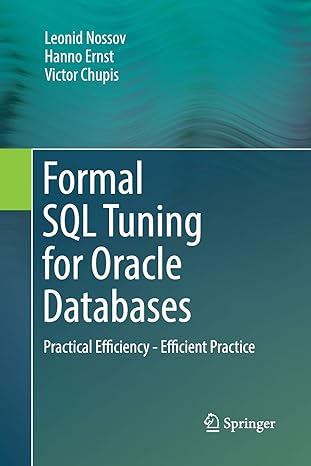Question
5. 6. Final challenge For your final challenge in this unit, you will load two files. The first file F1 will have information about some
5. 6. Final challenge
For your final challenge in this unit, you will load two files. The first file F1 will have information about some accounts. It will be pipe-delimited and have one record per line, with these fields:
ACCOUNT NUMBER | PIN CODE | BALANCE
The second file F2 will contain instructions: one on each line. The instructions will look like this:
COMMAND | AMOUNT | ACCOUNT NUMBER | PIN CODE
COMMAND will be either add or sub. If the command is add, you will add AMOUNTto the BALANCE in the account files F1. If the command is sub, you will subtract.
However, there are a number of reasons for which you may need to reject the transaction. If you are asked to subtract an amount that would put the account below zero or if the pin code you are provided does not match the pin code in the account record, the transaction is ignored.
# Get the filepath from the command line import sys F1= sys.argv[1] F2= sys.argv[2]
# Your code goes here
#sys for fetching command-line arguments #os for linesep import sys, os
#for retaining ordering from collections import OrderedDict
#fetch the command-line arguments and store them F1 = sys.argv[1] F2 = sys.argv[2]
#empty dictionary for holding balance data read from F1 balance_dict = OrderedDict()
#iterate through each line in F1 and store in the balance_dict with account number as the key #handle the case in which the file doesn't or the path is wrong try: #open F1 for reading with open(F1, 'r') as balance_file: for line in balance_file.readlines(): #split the line by "|", and store data, strip any extra white spaces account_number, pin_code, balance = line.strip().split("|") #strip white spaces for each variables account_number = account_number.strip() pin_code = pin_code.strip() balance = float(balance.strip()) #store the values into the dictionary balance_dict[account_number] = { "pin_code" : pin_code, "balance" : balance }
#open F2 for reading with open(F2, 'r') as transaction_file: #go through each line of F2 for line in transaction_file.readlines(): #extract data command, amount, account_number, pin_code = line.strip().split("|") #strip each variable string of extra white spaces, and convert into proper types as well command = command.strip() amount = float(amount.strip()) account_number = account_number.strip() pin_code = pin_code.strip()
#handle the case in which the key doesn't exist in the dict try: #check if the pin_code matches or not if pin_code == balance_dict[account_number]["pin_code"]: #check what the command is if command.lower() == "add": #add amount to balance balance_dict[account_number]["balance"] += amount elif command.lower() == "sub": #compute balance new_balance = balance_dict[account_number]["balance"] - amount #check if balance is negative or not if new_balance >= 0: #if not, update balance_dict[account_number]["balance"] -= amount except KeyError: print("Oops!! Account number doesn't exist in F1")
#open F1 for writing updated balances with open(F1, 'w') as balance_file: #go through each item in balance_dict for key in balance_dict: #construct the line to write to F1 line = key + "|" + balance_dict[key]["pin_code"] + "|" + str(balance_dict[key]["balance"]) + os.linesep balance_file.write(line)
except IOError: print("Either a file doesn't exist or a path is wrong!!")
Step by Step Solution
There are 3 Steps involved in it
Step: 1

Get Instant Access to Expert-Tailored Solutions
See step-by-step solutions with expert insights and AI powered tools for academic success
Step: 2

Step: 3

Ace Your Homework with AI
Get the answers you need in no time with our AI-driven, step-by-step assistance
Get Started


